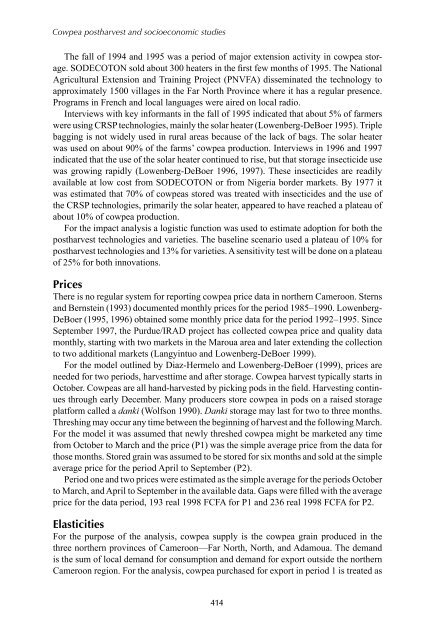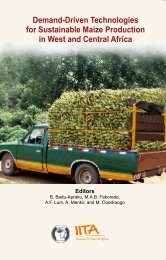Impact of cowpea breeding and storage research in Cameroon - IITA
Impact of cowpea breeding and storage research in Cameroon - IITA
Impact of cowpea breeding and storage research in Cameroon - IITA
Create successful ePaper yourself
Turn your PDF publications into a flip-book with our unique Google optimized e-Paper software.
Cowpea postharvest <strong>and</strong> socioeconomic studies<br />
The fall <strong>of</strong> 1994 <strong>and</strong> 1995 was a period <strong>of</strong> major extension activity <strong>in</strong> <strong>cowpea</strong> <strong>storage</strong>.<br />
SODECOTON sold about 300 heaters <strong>in</strong> the first few months <strong>of</strong> 1995. The National<br />
Agricultural Extension <strong>and</strong> Tra<strong>in</strong><strong>in</strong>g Project (PNVFA) dissem<strong>in</strong>ated the technology to<br />
approximately 1500 villages <strong>in</strong> the Far North Prov<strong>in</strong>ce where it has a regular presence.<br />
Programs <strong>in</strong> French <strong>and</strong> local languages were aired on local radio.<br />
Interviews with key <strong>in</strong>formants <strong>in</strong> the fall <strong>of</strong> 1995 <strong>in</strong>dicated that about 5% <strong>of</strong> farmers<br />
were us<strong>in</strong>g CRSP technologies, ma<strong>in</strong>ly the solar heater (Lowenberg-DeBoer 1995). Triple<br />
bagg<strong>in</strong>g is not widely used <strong>in</strong> rural areas because <strong>of</strong> the lack <strong>of</strong> bags. The solar heater<br />
was used on about 90% <strong>of</strong> the farms’ <strong>cowpea</strong> production. Interviews <strong>in</strong> 1996 <strong>and</strong> 1997<br />
<strong>in</strong>dicated that the use <strong>of</strong> the solar heater cont<strong>in</strong>ued to rise, but that <strong>storage</strong> <strong>in</strong>secticide use<br />
was grow<strong>in</strong>g rapidly (Lowenberg-DeBoer 1996, 1997). These <strong>in</strong>secticides are readily<br />
available at low cost from SODECOTON or from Nigeria border markets. By 1977 it<br />
was estimated that 70% <strong>of</strong> <strong>cowpea</strong>s stored was treated with <strong>in</strong>secticides <strong>and</strong> the use <strong>of</strong><br />
the CRSP technologies, primarily the solar heater, appeared to have reached a plateau <strong>of</strong><br />
about 10% <strong>of</strong> <strong>cowpea</strong> production.<br />
For the impact analysis a logistic function was used to estimate adoption for both the<br />
postharvest technologies <strong>and</strong> varieties. The basel<strong>in</strong>e scenario used a plateau <strong>of</strong> 10% for<br />
postharvest technologies <strong>and</strong> 13% for varieties. A sensitivity test will be done on a plateau<br />
<strong>of</strong> 25% for both <strong>in</strong>novations.<br />
Prices<br />
There is no regular system for report<strong>in</strong>g <strong>cowpea</strong> price data <strong>in</strong> northern <strong>Cameroon</strong>. Sterns<br />
<strong>and</strong> Bernste<strong>in</strong> (1993) documented monthly prices for the period 1985–1990. Lowenberg-<br />
DeBoer (1995, 1996) obta<strong>in</strong>ed some monthly price data for the period 1992–1995. S<strong>in</strong>ce<br />
September 1997, the Purdue/IRAD project has collected <strong>cowpea</strong> price <strong>and</strong> quality data<br />
monthly, start<strong>in</strong>g with two markets <strong>in</strong> the Maroua area <strong>and</strong> later extend<strong>in</strong>g the collection<br />
to two additional markets (Langy<strong>in</strong>tuo <strong>and</strong> Lowenberg-DeBoer 1999).<br />
For the model outl<strong>in</strong>ed by Diaz-Hermelo <strong>and</strong> Lowenberg-DeBoer (1999), prices are<br />
needed for two periods, harvesttime <strong>and</strong> after <strong>storage</strong>. Cowpea harvest typically starts <strong>in</strong><br />
October. Cowpeas are all h<strong>and</strong>-harvested by pick<strong>in</strong>g pods <strong>in</strong> the field. Harvest<strong>in</strong>g cont<strong>in</strong>ues<br />
through early December. Many producers store <strong>cowpea</strong> <strong>in</strong> pods on a raised <strong>storage</strong><br />
platform called a danki (Wolfson 1990). Danki <strong>storage</strong> may last for two to three months.<br />
Thresh<strong>in</strong>g may occur any time between the beg<strong>in</strong>n<strong>in</strong>g <strong>of</strong> harvest <strong>and</strong> the follow<strong>in</strong>g March.<br />
For the model it was assumed that newly threshed <strong>cowpea</strong> might be marketed any time<br />
from October to March <strong>and</strong> the price (P1) was the simple average price from the data for<br />
those months. Stored gra<strong>in</strong> was assumed to be stored for six months <strong>and</strong> sold at the simple<br />
average price for the period April to September (P2).<br />
Period one <strong>and</strong> two prices were estimated as the simple average for the periods October<br />
to March, <strong>and</strong> April to September <strong>in</strong> the available data. Gaps were filled with the average<br />
price for the data period, 193 real 1998 FCFA for P1 <strong>and</strong> 236 real 1998 FCFA for P2.<br />
Elasticities<br />
For the purpose <strong>of</strong> the analysis, <strong>cowpea</strong> supply is the <strong>cowpea</strong> gra<strong>in</strong> produced <strong>in</strong> the<br />
three northern prov<strong>in</strong>ces <strong>of</strong> <strong>Cameroon</strong>—Far North, North, <strong>and</strong> Adamoua. The dem<strong>and</strong><br />
is the sum <strong>of</strong> local dem<strong>and</strong> for consumption <strong>and</strong> dem<strong>and</strong> for export outside the northern<br />
<strong>Cameroon</strong> region. For the analysis, <strong>cowpea</strong> purchased for export <strong>in</strong> period 1 is treated as<br />
414
















